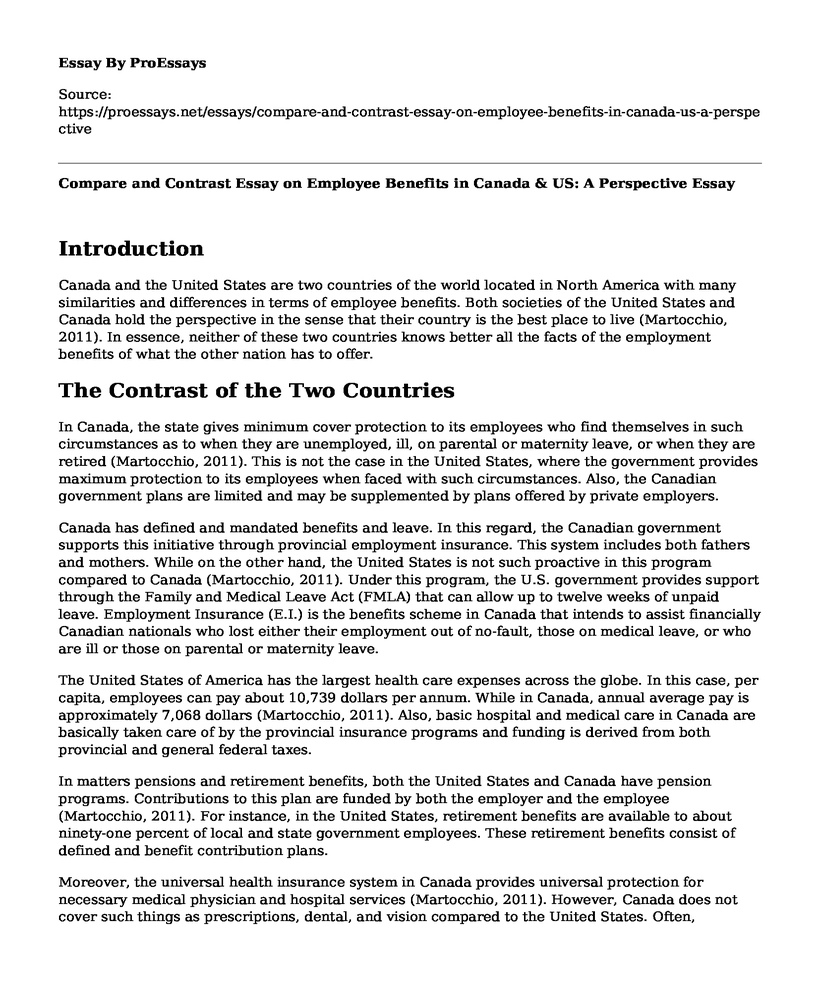Introduction
Canada and the United States are two countries of the world located in North America with many similarities and differences in terms of employee benefits. Both societies of the United States and Canada hold the perspective in the sense that their country is the best place to live (Martocchio, 2011). In essence, neither of these two countries knows better all the facts of the employment benefits of what the other nation has to offer.
The Contrast of the Two Countries
In Canada, the state gives minimum cover protection to its employees who find themselves in such circumstances as to when they are unemployed, ill, on parental or maternity leave, or when they are retired (Martocchio, 2011). This is not the case in the United States, where the government provides maximum protection to its employees when faced with such circumstances. Also, the Canadian government plans are limited and may be supplemented by plans offered by private employers.
Canada has defined and mandated benefits and leave. In this regard, the Canadian government supports this initiative through provincial employment insurance. This system includes both fathers and mothers. While on the other hand, the United States is not such proactive in this program compared to Canada (Martocchio, 2011). Under this program, the U.S. government provides support through the Family and Medical Leave Act (FMLA) that can allow up to twelve weeks of unpaid leave. Employment Insurance (E.I.) is the benefits scheme in Canada that intends to assist financially Canadian nationals who lost either their employment out of no-fault, those on medical leave, or who are ill or those on parental or maternity leave.
The United States of America has the largest health care expenses across the globe. In this case, per capita, employees can pay about 10,739 dollars per annum. While in Canada, annual average pay is approximately 7,068 dollars (Martocchio, 2011). Also, basic hospital and medical care in Canada are basically taken care of by the provincial insurance programs and funding is derived from both provincial and general federal taxes.
In matters pensions and retirement benefits, both the United States and Canada have pension programs. Contributions to this plan are funded by both the employer and the employee (Martocchio, 2011). For instance, in the United States, retirement benefits are available to about ninety-one percent of local and state government employees. These retirement benefits consist of defined and benefit contribution plans.
Moreover, the universal health insurance system in Canada provides universal protection for necessary medical physician and hospital services (Martocchio, 2011). However, Canada does not cover such things as prescriptions, dental, and vision compared to the United States. Often, employers provide other insurance services to their workers through group insurance programs to cushion such types of medical necessities.
Best Practice In Canada
Despite the differences and similarities discussed above concerning the benefits of employees in these two countries, there is something that stood up in Canada, among other things discussed in both countries that got my attention. The Canadian government is centrally moving towards a significant percentage of their employees being covered under defined contribution programs. But in the United States, this idea is still being lagging in converting its workers from Defined Benefit (D.B.) to Defined Contribution (D.C.) programs. This is one of the most significant items that got my attention (Martocchio, 2011). Also, Canada has a vital stronger and tighter union movement compared to the United States. In this case, Canada has more collective bargaining power than the U.S., which plays a very vital role in benefits and pension than in the United States. The United States needs to change its system and attitude and should emphasize adherence to laid down-clearly defined regulations and rules that provide a level safeguard and protection to the employees. This will help the U.S. to improve the benefits of its employees.
Reference
Martocchio, J. J. (2011). Employee benefits: A primer for human resource professionals. New York: McGraw-Hill Irwin.
Cite this page
Compare and Contrast Essay on Employee Benefits in Canada & US: A Perspective. (2023, May 07). Retrieved from https://proessays.net/essays/compare-and-contrast-essay-on-employee-benefits-in-canada-us-a-perspective
If you are the original author of this essay and no longer wish to have it published on the ProEssays website, please click below to request its removal:
- Essay on the Financial System in the U.S.
- Film Capitalism: A Love Story Essay
- Essay Sample on Measuring GDP and Progress of Societies
- Traveling to the Future or Past: Changing Experiences in Afghanistan Essay Example
- Vietnam: 30-Year Economic Growth, Poverty Reduction and GDP Increase - Essay Sample
- Essay Example on Creating an Equitable Payment Plan: Dessler's Five-Step Process
- How Spark NZ Limited Can Strategically Adapt to Dynamic Telecommunication Industry - Essay Sample







